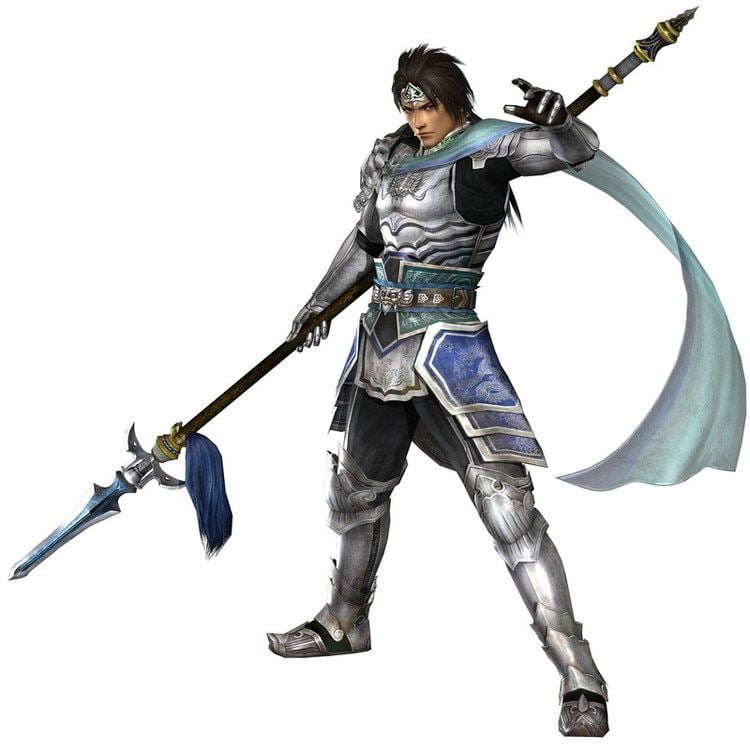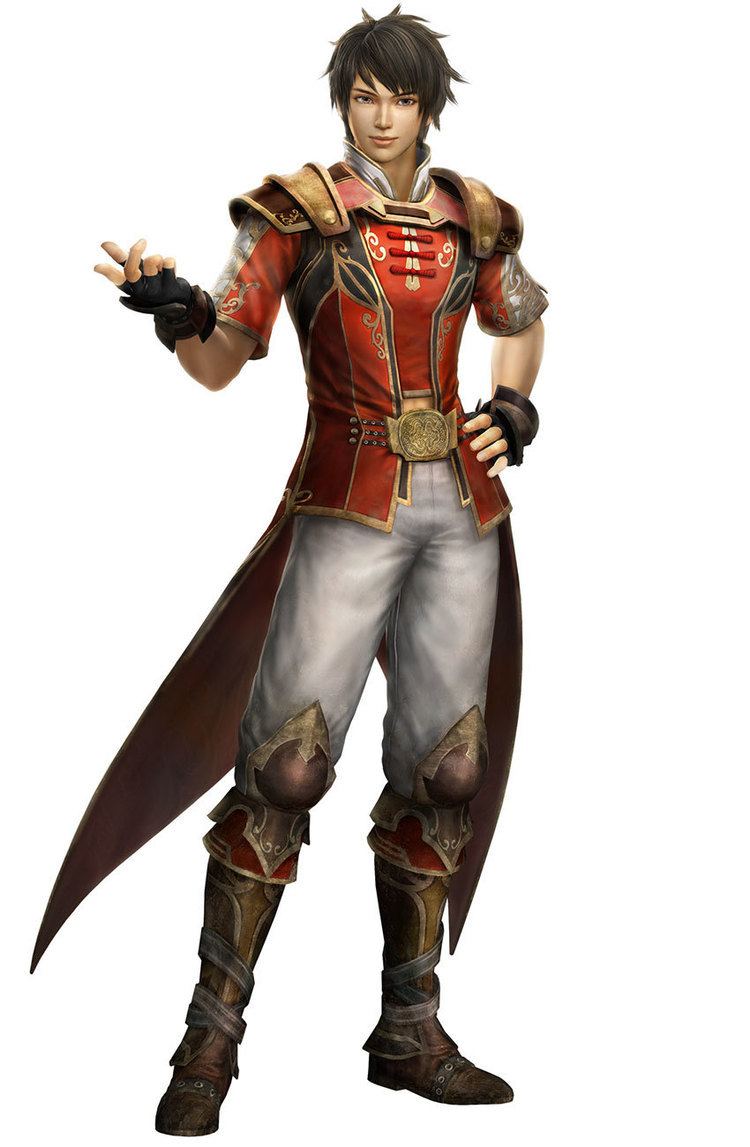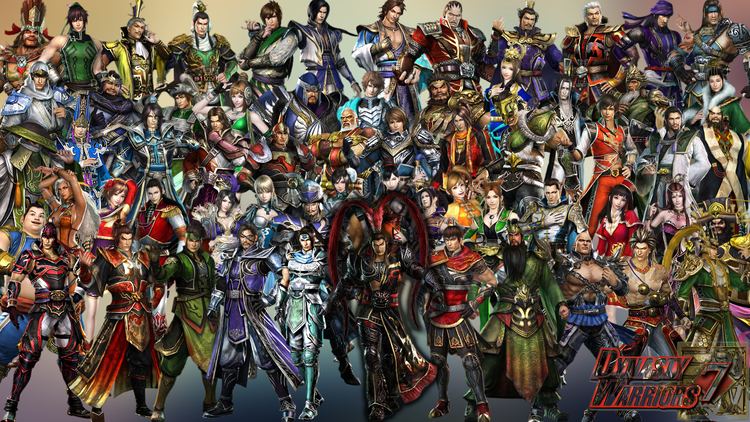 | ||
First release Dynasty WarriorsFebruary 28, 1997 Latest release Arslan: The Warriors of LegendOctober 1, 2015 Spin-offs Samurai WarriorsWarriors OrochiDynasty TacticsDynasty Warriors: GundamFist of the North Star: Ken's RageWarriors: Legends of TroyOne Piece: Pirate WarriorsHyrule WarriorsDragon Quest HeroesArslan: The Warriors of LegendFire Emblem Warriors Designers Koei, Omega Force, Kenichi Ogasawara Games Berserk, Dynasty Warriors: Godseekers, Dynasty Warriors 8: Empires, Dynasty Warriors 8: Xtreme L, Dynasty Warriors 8: Xtreme L | ||
Dynasty warriors history and evolution 1997 2014
Dynasty Warriors (真・三國無双, Shin Sangokumusō, literally translated as "True ・ Three Kingdoms Unrivalled") is a series of tactical action video games created by Omega Force and Koei. The award-winning series is a spin-off of Koei's turn-based strategy Romance of the Three Kingdoms series, based loosely around the Chinese historical text Records of the Three Kingdoms, from which it derives its name in Japanese.
Contents
- Dynasty warriors history and evolution 1997 2014
- Dynasty warriors 8 video review
- Main series
- Xtreme Legends and Empires
- Portable games
- PC games
- Characters
- Spin offs
- Film adaption
- Stages
- Music
- References

The first game titled Dynasty Warriors, Sangokumusō in Japan, is a fighting game and different from the rest of the series. All English titles are a number ahead of their Japanese counterparts due to the English localization of naming Shin Sangokumusō, a spin-off of the previously mentioned Sangokumusō game, as Dynasty Warriors 2.

It is Koei's most successful franchise. Including its many spin-offs, 18 million copies of the Dynasty Warriors series have sold worldwide by 2011.
Dynasty warriors 8 video review
Main series

The first Dynasty Warriors (Sangokumusō) is a traditional one-on-one fighting game, released in 1997 for the PlayStation. Its gameplay style is reminiscent of Virtua Fighter and Soul Blade.
The next game was released in Japan as Shin Sangokumusou. This game was released in other countries as Dynasty Warriors 2, leading to the discrepancy in title numbers. From this game onwards, the player chooses a playable character and plays a number of levels representing particular battles in the Three Kingdoms period, eventually defeating all other rival kingdoms and uniting China under a common ruler. In this game mode, known as "Musou Mode", the generals are usually chosen from one of the three kingdoms (Wu, Shu or Wei; however, from Dynasty Warriors 3: Xtreme Legends onwards, independent generals were given full stories as well). Dynasty Warriors 3 has two secret characters, Nü Wa and Fu Xi, that are not playable in Musou Mode.
Dynasty Warriors 2, Dynasty Warriors 3, Dynasty Warriors 5 and Dynasty Warriors 6 have individual Musou Modes for each character. In Dynasty Warriors 4, Dynasty Warriors 7, and Dynasty Warriors 8, each of the Three Kingdoms has its own Musou Mode, which all characters from a particular kingdom would play. The stages are presented in a third-person view, with the camera set behind the player as they engage the enemy forces. Each scenario can have different win/lose conditions, but the common losing conditions (defeat of the commander-in-chief, health bar reaching zero and maximum time limit reached) still hold. As for the other characters not from either of the Three Kingdoms, their Musou story modes are purely fictional since in Romance of the Three Kingdoms, most or all of them were eliminated until only the Three Kingdoms were left.
In Dynasty Warriors 5, a relatively more realistic Musou Mode is introduced for each character. Instead of participating in the entire set of their kingdoms' events, the characters appear only in certain battles that they had fought in, as according to the novel or factual history. Therefore, characters will start at different points in time and they may never have opportunities to encounter some of the other characters (e.g.: Zhuge Liang will never meet Lü Bu or Dong Zhuo in his Musou Mode). In between stages there are some dramatic cutscenes, in which the character will express his/her thoughts on the situation, adding a more personal touch and keeping the player updated on the events. Besides, a character's Musou Mode may end before the unification of China at any point of time, stopping for most at their historical point of death. However, some characters such as the three founders may continue to participate in battles that occurred after their deaths (e.g.: Cao Cao appearing in Battle of Wuzhang Plains), representing an extended leadership under more successful circumstances.
Xtreme Legends and Empires
In 2002, an Xtreme Legends (Moushouden in Japan) expansion was first released for the main games, beginning with Dynasty Warriors 3. This expansion features new Musou Modes for the characters in the Other category as well as new stages, weapons, items, and modes. The Xtreme Legends expansion only have the new contents by its own, so players would require the original game disc and use the "Mixjoy" option to access all features. The following games would continue the tradition by having Xtreme Legends expansion, save for Dynasty Warriors 6. New characters were also added through the Xtreme Legends starting with Dynasty Warriors 7.
Beginning in 2004, another expansion line, titled Empires was first released for Dynasty Warriors 4. In Empires, the game would combine the action gameplay of the regular series with strategical and tactical elements from Koei's earlier series Romance of the Three Kingdoms. Unlike the Xtreme Legends, Empires did not require the original game disc to access all of its features as it is considered a unique game of its own. Again, the following games would continue having the Empires expansion, including Dynasty Warriors 6, which did not receive an Xtreme Legends expansion.
Portable games
In 2004, Koei created the first Dynasty Warriors title for portable game handhelds, Dynasty Warriors, on PlayStation Portable, and in the following year, Dynasty Warriors Advance for Game Boy Advance. The sequel of the first PSP game, Dynasty Warriors Vol. 2 was released in 2006. In 2007, Koei released Dynasty Warriors DS: Fighter's Battle for the Nintendo DS. Another PSP game based on Dynasty Warriors 6, Dynasty Warriors: Strikeforce was released in 2009, which was followed up by a sequel, Shin Sangokumusō: Multi Raid 2 in 2010. A PlayStation Vita game Dynasty Warriors Next was released in 2011 as a launch title, and a Nintendo 3DS game, Shin Sangokumusō VS (真・三國無双 VS) was released in April 2012.
Other than titles specifically made for handhelds, select main Dynasty Warriors titles have also been ported to handhelds, all of which are only available in Japan. The PS2 version of Dynasty Warriors 6, Dynasty Warriors 6: Special was also ported to the PSP, which was soon followed by the Empires expansion in 2010. A port of Dynasty Warriors 7, Shin Sangokumusou 6: Special was released in 2011 for PSP, based on the Xtreme Legends expansion but without including the three new characters added for the expansion. A PS Vita port of Dynasty Warriors 8 was released in 2013, which includes features from the Xtreme Legends expansion for that game. Later, in 2015, the Empires expansion of Dynasty Warriors 8 was also released on the PS Vita, notably also compatible with the PlayStation TV.
PC games
Dynasty Warriors 4: Hyper in 2005 is marked as the first DW game for the PC. Hyper was a port of Dynasty Warriors 4 for the PS2, and had harder AI, more enemies on screen and smoother textures.
In 2006, Dynasty Warriors BB (renamed Dynasty Warriors Online in 2007) was released as an online game. As of January 10, 2014 Aeria Games shut down the servers for Dynasty Warriors Online in America. Next to Dynasty Warriors 4: Hyper, Dynasty Warriors 6 was released for PC in 2008. Dynasty Warriors 5 Special was released for PC in 2006. Also Samurai Warriors 2 released in 2009. The PC port of Dynasty Warriors 7 with Extreme Legends was released on March 9, 2012.
Dynasty Warriors 8: Xtreme Legends Complete Edition released on Steam on May 13, 2014.
Dynasty Warriors 8: Empires released on Steam on February 27, 2015.
Characters
The Dynasty Warriors game series, although referenced to factual people, is known for changing the traditional ways of how some of the historical characters were depicted in Romance of the Three Kingdoms or in historical records. For example, Zhang He appears to be more feminine while Wei Yan becomes a bestial tribal warrior, while historical accounts depict both to be relatively normal generals with no outstanding characteristics such as these. Some of them also wield weapons that are anachronistic, such as Ling Tong's nunchaku and Sun Ce's tonfas. A touch of mysticism is also added, as some characters such as Zhuge Liang, Sima Yi and Zuo Ci have the ability to use magic in their attacks. Female characters (except Zhurong and Wang Yi) who did not participate in any battles in the novel or in history are depicted as fearsome female warriors with exceptional fighting skills and weapons.
A total of 87 characters have been made playable at some point in the series (not counting spin-offs); however, only 83 currently make mainstay appearances as of Dynasty Warriors 8: Empires. Each of these characters is armed with a weapon that may be a conventional historical one, an exotic martial arts weapon or a magical weapon that enhances his/her mystical powers. From Dynasty Warriors 3 onward, each character can choose from a range of weapons with his/her own power-ups and ability enhancements, as well as higher-level weapons that extend his/her attack chain.
Spin-offs
Following the success of Dynasty Warriors, Koei released Dynasty Tactics in 2002 and its sequel in the following year, focusing on strategy and tactics in the same Three Kingdoms setting.
Probably the third most recognized franchise of Koei, Samurai Warriors (Sengoku Musou in Japan) series, was introduced in 2004. Instead of the Three Kingdoms era, the series uses Japan's Sengoku period. As a result, the game's roster consists of characters from that era, while having gameplay similar to that of Dynasty Warriors. The game would be followed by Samurai Warriors 2 in 2006, Samurai Warriors 3 in 2009, and Samurai Warriors 4 in 2014 as well as numerous other spin-off titles. As with the original series, Samurai Warriors also has the Xtreme Legends and Empires expansions, with the former beginning on the first game and the latter on the second game.
A tactical role-playing game, Shin Sangoku Musou: Eiketsuden was announced on April 5, 2016 with a Japanese release date in 2016 for the PlayStation 3, PlayStation 4, and PlayStation Vita. It will be the series' first strategy RPG, featuring a turn-based system and a world map. The game will also completely deviate from history by introducing a completely new story line involving fictitious mystical elements, with Zhao Yun as the main protagonist.
Other related titles include:
Film adaption
A live action film based on the game series was announced in March 2016. It will be produced by Hong Kong-based China 3D, written by Christine To and directed by Roy Hin Yeung Chow, and is scheduled to be released in China, Hong Kong, and Macau in 2018.
Stages
Many of the stages are recreations of notable battles in the late Han Dynasty and Three Kingdoms periods, that are usually depicted in Romance of the Three Kingdoms. There are also some original creations in the newer installments that are also historical, such as the battle between the Nanman and Wu. The following is a list of common stages featured in almost all the installments:
Music
The music for the Dynasty Warriors game series is a mixture of traditional Chinese instrumentals, hard rock and heavy metal. Most stages have their own exclusive music tracks played and the tracks change according to the battle situation or events.
